Ka with ascender (k; italics: k) is a letter of the Cyrillic script which was used in Kabardian at the start of the 20th century.
Ka with ascender (k; italics: k) is a letter of the Cyrillic script which was used in Kabardian at the start of the 20th century.
In turkology, Vasily Radlov used ka with ascender ⟨k⟩ in the mixed alphabet (a mix of Latin and Cyrillic) in his dictionary of Turkic language dialects in 4 volumes published between 1893 and 1911. [1]



This letter does not have any computing codes, most notably in Unicode. It is possible to approximate this letter with the Latin letter K in the fonts where it looks different from the Cyrillic letter Ka and k.

Kabardian also known as East Circassian, is a Northwest Caucasian language closely related to the Adyghe language. Circassian nationalists reject the distinction between the two languages and refer to them both as "Circassian".

Adyghe is a Northwest Caucasian language spoken by the western subgroups of Circassians. It is spoken mainly in Russia, as well as in Turkey, Jordan, Syria and Israel, where Circassians settled after the Circassian genocide by the Russian Empire. It is closely related to the Kabardian language, though some reject the distinction between the two languages in favor of both being dialects of a unitary Circassian language.
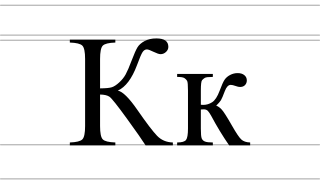
Ka is a letter of the Cyrillic script.

Kje is a letter of the Cyrillic script, used only in the Macedonian alphabet, where it represents the voiceless palatal plosive, or the voiceless alveolo-palatal affricate. Kje is the 24th letter in this alphabet. It is romanised as ⟨ḱ⟩ or sometimes ⟨ķ⟩ or ⟨kj⟩.

Koppa is an archaic numeral character of the Cyrillic script. Its form are derived from some forms of the Greek letter Koppa (Ϙ ϙ).

The Kyrgyz alphabets are the alphabets used to write the Kyrgyz language. Kyrgyz uses the following alphabets:
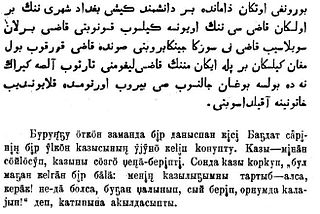
Three alphabets are used to write Kazakh: the Cyrillic, Latin and Arabic scripts. The Cyrillic script is used in Kazakhstan and Mongolia. An October 2017 Presidential Decree in Kazakhstan ordered that the transition from Cyrillic to a Latin script be completed by 2031. The Arabic script is used in Saudi Arabia, Iran, Afghanistan, and parts of China.

Qaf, or Ka with descender, is a letter of the Cyrillic script used in a number of non-Slavic languages spoken in the territory of the former Soviet Union, including:
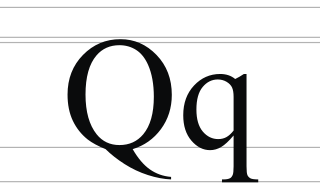
Qa is a letter of the Cyrillic script. Its form is based on the Latin letter Q (Q q). Depending on the font, the uppercase form can look like a reversed Cyrillic letter Р, with the lowercase form also resembling a reversed Cyrillic letter Р.

Bashkir Qa or Bashkir Ka is a letter of the Cyrillic script. It is formed from the Cyrillic letter Ka (К к) with the top extending horizontally to the left. It corresponds to Қ in Kazakh and Karakalpak and other Turkic languages.

Ka with vertical stroke is a letter of the Cyrillic script. Its form is derived from the Cyrillic letter Ka (К к) by the addition of a stroke through the short horizontal bar in the centre of the letter.

Ka with stroke is a letter of the Cyrillic script. It is formed from the Cyrillic letter Ka (К к) by adding a stroke through the upper part of the vertical stem of the letter.
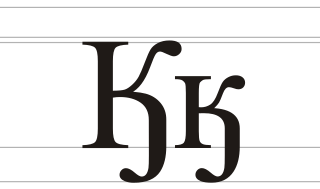
Ka with hook is a letter of the Cyrillic script. It is formed from the Cyrillic letter Ka (К к) by the addition of a hook.
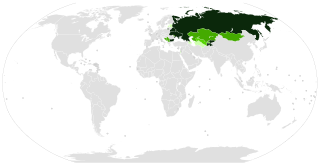
Numerous Cyrillic alphabets are based on the Cyrillic script. The early Cyrillic alphabet was developed in the 9th century AD and replaced the earlier Glagolitic script developed by the theologians Cyril and Methodius. It is the basis of alphabets used in various languages, past and present, Slavic origin, and non-Slavic languages influenced by Russian. As of 2011, around 252 million people in Eurasia use it as the official alphabet for their national languages. About half of them are in Russia. Cyrillic is one of the most-used writing systems in the world. The creator is Saint Clement of Ohrid from the Preslav literary school in the First Bulgarian Empire.

The Latin letter K with descender is a Latin letter.

Aleut Ka is a letter of the Cyrillic script. It is formed from the Cyrillic letter Ka (К к) by adding a stroke to the upper diagonal arm.
The Cyrillic script family contains many specially treated two-letter combinations, or digraphs, but few of these are used in Slavic languages. In a few alphabets, trigraphs and even the occasional tetragraph or pentagraph are used.
JCUKEN is the main Cyrillic keyboard layout for the Russian language in computers and typewriters. Earlier in Russia JIUKEN (ЙІУКЕН) layout was the main layout, but it was replaced by JCUKEN when the Russian alphabet reform of 1917 removed the letters Ѣ, І, Ѵ, and Ѳ. The letter Ъ had decreased in usage significantly after the reform.
Khakass alphabets are the alphabets used to write the Khakas language.